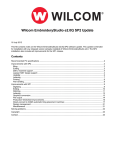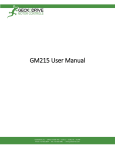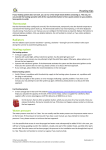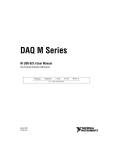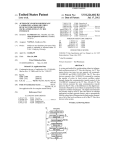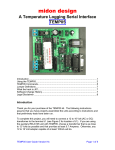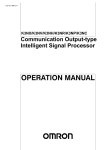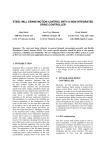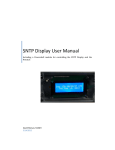Download Project report - Electrical and Information Technology
Transcript
Digital boost pressure controller Carl Wilhelmsson 791108-3934 e99cwi “Digitala project 5p” vt 05 Abstract This is the brief report of the development of a digital turbo boost pressure controller. More and more of the modern cars features a turbo charger and they are often electrically controlled from the engine control unit (ECU). However raising the boost pressure of the turbo charger often offers a very simple way of tuning the car. If a “boost up” is performed it is important to keep track of the actual boost pressure, as well as controlling it accurately. It might also be interesting to perform certain intelligent manipulation of it. This report briefly describes prototype circuit board and prototype software that gives a baseline for interesting boost pressure control systems. This work has been performed as the assignment in the course “Digitala project”. For use in an actual car extra concerns has to be taken, and the software has to be changed a bit. Of course no claims can be held against any form of usage of this experimental setup or the published information, neither of caused damage, nor of correctness. -2- Table of contents 1 Introduction.............................................................................................................- 4 1.1 System specification .......................................................................................- 4 1.2 Function and implementation .........................................................................- 4 1.2.1 Engine speed measurement.....................................................................- 4 1.2.2 Boost pressure measurement...................................................................- 5 1.2.3 Boost pressure control.............................................................................- 5 1.2.4 Boost pressure actuator ...........................................................................- 5 1.3 Possible extensions .........................................................................................- 6 2 Hardware.................................................................................................................- 6 2.1 Microcontroller ...............................................................................................- 6 2.2 LCD display ....................................................................................................- 7 2.3 “The rest” ........................................................................................................- 7 3 Software ..................................................................................................................- 8 3.1 LCD control ....................................................................................................- 8 3.2 Controller ........................................................................................................- 8 3.3 Engine speed ...................................................................................................- 9 3.4 Mail loop, user interface .................................................................................- 9 3.5 Interrupts .........................................................................................................- 9 4 Results...................................................................................................................- 10 4.1 Engine speed measurements .........................................................................- 10 4.2 AD converter, PI controller...........................................................................- 10 References.....................................................................................................................- 11 - Table of figures Figure 1, pin layout of the Atmel® AVR ATmega16 microcontroller ..........................- 6 - Table of tables Table 1, development pin connection of the ATmega16................................................- 7 Table 2, the available functions used to control the LCD display. .................................- 8 Table 3, interrupt name and application usage. ............................................................- 10 - -3- 1 Introduction This project started out as a lambda (the relation between actual and desired fuel amount in an engine) measuring/logging device. But as the lambda sensor proved to need a very difficult circitivity the project aims had to be changed for a digital boost controller (which contains similar software as the lambda measuring device would have done). The digital boost controller is also a very useful device, and the prototype device has many interesting add-ons to implement. 1.1 System specification To be useful the boost controller has to be able to control the boost pressure. This will be obtained by using a SAAB® PWM pressure actuator which are able to “bleed” the pressure fed to the normal metal spring operated waste-gate clock on a normal turbo car. Using this actuator it is possible to control the boost pressure of the engine by changing the pressure in the waste-gate clock. The boost pressure needs to be controlled fairly accurate. The controller shall maintain the selected pressure, that is: • • • • The selected boost-pressure shall be maintained by controlling the waste-gate clock pressure using the PWM output The controller shall display four different values o Actual current boost pressure o Set point of desired boost pressure o The “controller on” limit pressure o The engine speed [rpm] It shall be possible to change the desired “controller on” limit pressure and the desired boost pressure The manipulation of the set points shall be performed using two switches o One switch increasing the set point o One switch to decrease the set point o If both switches is pressed simultaneously the current manipulated set point value shall be changed 1.2 Function and implementation The main idea it to let the ATmega16 perform all the actual work, software are constructed to perform printouts of the desired values on the LCD display, and the other additional components is only to provide the microcontroller with suitable input/output facilities. 1.2.1 Engine speed measurement To be able to measure the engine speed a TTL compatible wave form is needed from the engine. A suitable source of this waveform would be a magnetic pickup on for example one of the ignition cables (or some other electronic component with similar behaviour). -4- Because of the high impedance and sensitive nature of these systems it is not recommendable to galvanic connect anything to the actual engine control system. For this prototype it is assumed that the actual circitivity performing this generation of a TTL waveform already exists, and the waveform is hence simulated with a normal waveform generator. The timer/counter 0 in the AVR is then set to external trig (connected to pin 1 of the AVR), this makes the t/c 0 count every event (i.e. spark) on the TTL compatible waveform. The t/c 2 is also initiated, but this t/c is set to operate on the internal oscillator. If the t/c 2 is prescaled (using both software interrupt driven prescaling, and hardware prescaling) in a suitable manner it will be a suitable time base for the engine ignition counter. That is when the corresponding overflow interrupt arrives on t/c 2 the value of t/c 0 is read to a global variable. Then t/c 0 is set to zero to again count the events of the engine. The global variable then describes the number of sparks being fed to the engine during the fix given time decided by t/c 2 prescaling. The engine speed can hence be easily calculated and displayed on the LCD. 1.2.2 Boost pressure measurement To be able to measure the boost pressure the internal AD converter is utilized. It is set up as single ended measurements performing a mean average including 16 samples (since it is possible to perform division by switching 4 bit). The AD converter is set up in a form of “semi free run” mode, as each sample is finished a new one is started in the interrupt routine. If 16 samples has been taken the current channel is switched using the internal multiplexer. In this manner all eight channels is sampled and stored away in a global vector. Even tough only one channel is used this arrangement may come in handy in the extension applications. 1.2.3 Boost pressure control To channel one there is a PI controller attached which is updated as soon as a new sample is available. Note that it is due to the periodic nature of the PI controller is important that the consecutive time between each update of the PI controller is the same every time. For a description of the PI controller please refer to [ 4]. The details of the discretization of the PI is totally excluded here but note that a new controller can be attached to each of the eight AD channels in the same manner, but then more attributes has to be declared. The PI controller shall be switched on when it is above the PI-on pressure limit. When the pressure again falls below the PI-on limit, the state of the controller shall be zeroed the controller shall be switched off and the controller output shall be set to zero as well. 1.2.4 Boost pressure actuator As mentioned earlier the boost pressure actuator consists of a SAAB® PWM “bleeding valve” this actuator can be found on many SAAB® turbo engines. The output from the AVR to the bleeding valve is a PWM waveform. The PWM modulation frequency shall be around 32 Hz (but probably a slightly higher frequency is also possible to use). If an AVR frequency of 8MHz is used the t/c 1 can be set to 256 prescaling and 10bit operation to obtain (about) this frequency. -5- The current to the bleeding valve shall then be fed through a switching transistor, but this analogue part has not been constructed. 1.3 Possible extensions There are basically an infinite amount of possibilities to extend this device. The most interesting should be a controller for the so called blow-off valve that also exists in most turbo charged engines, and that also is a significant factor controlling the boost pressure (but during transients). It can also be interesting to have different driver modes, controlling boost pressure differently depending on the desires of the driver. 2 Hardware 2.1 Microcontroller For this application Atmega16 from Atmel [1] is the most suitable device. This nice microcontroller contains everything you might need to design a boost controller, given every possible ”bling bling” you might want to implement. And it is possible to extend the features of the controller far. In this task the main features used in the microcontroller are the AD converter and the timer/counters. The JTAG interface is used for debugging. After all f the desired components (such as display and so on) are connected there still exist plenty of free inputs. Figure 1, pin layout of the Atmel® AVR ATmega16 microcontroller -6- AVR pin 1 2 3 4 5 6 7 8 9 10 11 12 19 22 23 24-27 30 31 33-36 37-39 40 Usage, and connection TTL input for ignition counter, from signal generator LCD R LCD R/W LCD E LCD DB0 LCD DB1 LCD DB2 LCD DB3 Vcc +5v GND 0V RXD serial com output to MAX233 pin 7 TXD serial com input to MAX233 pin8 PWM actuator output Switch input (active low) Switch input (active low) JTAG communication see [ 5] ADC voltage reference +5v (Vcc) ADC GND Sampled (but not connected) Sampled not used ADC inputs, connected to trim resistor, 0-4.9V to ADC Sampled 0-4.9V ADC, used for PI controller Table 1, development pin connection of the ATmega16. 2.2 LCD display To be able to visualise the measured (and controlled) boost pressure, the microcontroller is connected to a LCD display for visualization. The selected display of use is an alpha numeric two row 20 sign display, this for simplicity. Software is implemented in the AVR to control the display in a suitable manner, this is described in Software. For the technical description of the display check the datasheet [ 2]. 2.3 “The rest” Besides the microcontroller the development board only contains two switch buttons, a few potentiometers to experiment with the AD converter, a few resistors and condensators to arrange with suitable power supply. The board contains the MAX233 [ 3] used to convert RS232 to TTL levels, and a 9 pin d-sub connector to be able to connect the board to a PC. A connection for the JTAG is also supplied. -7- 3 Software Here the software will be discussed briefly. No claim of a complete description of the software is taken, only a brief description of the main functionality. 3.1 LCD control The is a few functions needed to display characters on the display. The most difficult is the initiation routine which has to be performed in a very precise manner. When the routine LCDChar() is available it is possible to define a output stream and to use the C standard “printf “ function, this is also performed, and hence complete strings can be printed. That is after the initiation routine the very a very simple methodology to print strings is available: 1. Put the LCD cursor (address counter) position to the desired address (using LCDJumpTo(x,y) ) 2. Use printf function to print the desired string (using printf(“String”) ) Signature void LCDInit(void) void LCDClearScr(void) void LCDJumpTo(char row, char pos) void LCDHome(void) int LCDChar(char letter) void LCDCommand(char command) char LCDBusy(void) char LCDState(void) void LCDwait(void) Usage LCD initiation routine, afterwards printf is available Clear LCD screen Move the cursor to row, col Put the cursor to the top left position Display the character “letter “ on the current cursor position Send the given command to the display Check if the LCD is ready to receive more data Check the address counter and the busy flag of the LCD Wait for a long time, used in the LCDInit Table 2, the available functions used to control the LCD display. 3.2 Controller The software needed to perform the PI calculations is basically the same as in [ 4], it has tough been slightly adapted to fit the environment. When a ADC conversion complete interrupt arrives, and the PI input channel has a new mean average value available the output of the PI controller is calculated, it is also fed to the t/c OCR1A register for a new PWM duty cycle. Then the “update state” global flag is arisen. All this is performed inside the interrupt routine, but since it is important to limit the work inside the interrupt routine the update of the integral state is performed (by a call to PIUpdateState()) inside the main loop, and the global update flag is pulled low. -8- The controller consists only of a initiation routine and the update state routine (since it is invoked in the interrupt routine and the main loop). 3.3 Engine speed The engine speed measurement contains of the initiation routine which initiates t/c 0 and t/c 2 for operation as described above. The t/c overflow interrupts are enabled, and when interrupts arrive on the t/c 2 the value of t/c 0 is read out. If the t/c 0 overflow interrupt arrives, a overflow condition has occurred, as it is now the overflow is however not handled in any other way than setting a global flag once. To handle this in a better manner is a possible add-on. The visualization of the engine speed is performed in the main loop using the global variable put away from the interrupt routines. 3.4 Mail loop, user interface The main loop is a for(;;) loop, and it will loop forever. Inside this loop code is inserted to handle the up/down switches (to make the increment/decrement speed reasonable the LCDWait() routine is used to wait a short while. This will affect the controller performance during the manipulation of the values and a better method of making the change of these values reasonable fast is desirable, maybe a timer that is used anyway could be used to limit the change speed. 3.5 Interrupts As understood from before most of this applications performance is connected to the use of interrupts, the interrupt header files defined in gcc are used. It is however important to be careful to check the spelling when using this built in signal definitions. Please also note that the SIGNAL(SIG_NAME) is used instead of the INTERRUPT(SIG_NAME). This is done to avoid the interrupt to be interrupted by other interrupts. If INTERRUPT is used it must be done with extreme real-time care. Since this application not is very time dependant it is better to use the real-time safe SIGNAL. Please also note that the main routine and all routines called from it can be interrupted by a interrupt routine at ANY TIME this means that for example all of the LCD handling has to be performed ONLY from the main routine (since the LCD data transfer is performed in a split 4 bit mode. The resources used in the main loop can not be used in the interrupt routines. The communication between the main loop and the interrupt routines is performed by global variables. To make this perfect, a semaphore should be implemented for each of the shared resources. If semaphores exists, it is possible to share resources between the main loop and the interrupts. -9- Interrupt SIG_ADC (AD complete) SIG_OVERFLOW0 SIG_OVERFLOW2 Usage 8 channel ADC mean average of 16 samples. Update of PI controller ch1 T/C 0 overflow, no action (too high engine speed) T/C 2 overflow, checks the value of t/c 0 for speed measurement Table 3, interrupt name and application usage. 4 Results 4.1 Engine speed measurements The resulting engine speed measurement is felt quite (too) slow. The update frequency is not enough to be of any usage. This can depend on two things: • • Since the AVR is not run in 8Mhz using the JTAG ICE the calculation of prescaling etc is not correct. The method of measuring the engine speed is too slow. If a desired measurement area of 600-15000 rpm is required (as it is) frequencies between 10-250Hz should be measured. This means that the selected measuring method should be preferable (since a 8 bit counter is used) if the counters is set so that t/c 0 is checked two times each second a sufficient resolution should be obtained. LSB=240rpm, max rev=61440rpm. Which should be more than enough, note that since the design is made with a four stroke engine LSB gets quote large, by the simple reason that the ignition pulses is slow (only one sparkplug is used). A possible “build around” which also means a completely different solution should be to connect the ignition pulse to an external interrupt and to have one counter to measure the actual time. This however will probably prove to be a very noisy measurement method. If all frequencies are selected correctly the selected method should be the best for engine speed measurements (especially since the spark advance might be changed in between cycles). 4.2 AD converter, PI controller The selected usage of the AD converter proved to work very well. Eight stable and continuously updated AD channels are hence available for any purpose. The PI controller has not (due to lack of time) been tested on the real application. It has tough been used to control the voltage in a capacitor with a very successful result. The PI was able to control the control the voltage given any load disturbance with in its actuator limitations (min and max PWM duty cycle). - 10 - References [1] Atmel 8-bit AVR Microcontroller with 16K byte In-system programmable flash. Datasheet, http://www.it.lth.se/datablad/Processors/ATmega16.pdf . [ 2] Display unit user’s manual, Dot matrix LCD units. Datasheet, http://www.it.lth.se/datablad/display/LCD.pdf . [ 3] MAX232 TTL to RS232 driver. Datasheet, http://www.it.lth.se/datablad/periphery/communication/max232-233.pdf . [ 4] Computer Control: An Overview. Karl Johan Åström, Björn Wittenmark, Karl Erik Årzen. IFAC paper, http://www.ifac-control.org/publications/pbriefs/PB_Wittenmark_etal_final.pdf . [ 5] AVR060: JTAG ICE Communication Protocol. Datasheet, http://www.it.lth.se/digp/PDF_files/avr/jtag_ice_com.pdf . NOTE: All web references relates to the versions available 1/3 2005 - 11 -















